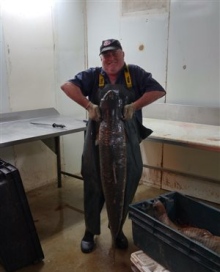 May 27th, 2016, Lanoraie, Quebec, fishermen captured a species of Asian Carp in the St. Lawrence River. There are four species of Asian Carp: Silver Carp, Bighead Carp, Grass Carp, and Black Carp. Asian Carp have become an increasing threat and alarming reality for the North American Great Lakes, and the mighty St. Lawrence River. Caught roughly two hours from Akwesasne Mohawk Territory, the capture of this species is a confirmation of their invasion to our local waterways.
May 27th, 2016, Lanoraie, Quebec, fishermen captured a species of Asian Carp in the St. Lawrence River. There are four species of Asian Carp: Silver Carp, Bighead Carp, Grass Carp, and Black Carp. Asian Carp have become an increasing threat and alarming reality for the North American Great Lakes, and the mighty St. Lawrence River. Caught roughly two hours from Akwesasne Mohawk Territory, the capture of this species is a confirmation of their invasion to our local waterways.
Asian carp were introduced to North America in the 1960’s & 1970’s to assist in the cleanup of algae in ponds, because of their ability to rapidly reproduce and their ability to eat up to 20% of their body weight in plankton each day. Because of the inability to contain these species, the Asian carp have since made their way into the Mississippi River, and migrated North through US waterways towards the Great Lakes, and now into the St. Lawrence River.
Asian carp threaten not only the native fish species in our waterways, but also pose a public safety hazard. These carp prefer cooler waters, and if they become established in local waters could potentially consume the food supply our native fish depend on, crowding them out of their natural habitat. Asian carp can grow to more than 25 cm in their first year, and can weigh up to 40 kilograms at maturity, which is equivalent to just under 90 lbs. Public safety hazards mostly lie with the Silver Carp, as boat vibrations cause them to jump out of the water, in some cases up to about three meters, equivalent to almost 10 feet, in the air. Many boaters and water-skiers in the Mississippi and Illinois rivers have been seriously injured by these jumping carp.
The reality is that these carp are getting dangerously close to Akwesasne, but there are some things the public can do to assist in keeping these species from overpowering the St. Lawrence River, and traveling north to the Great Lakes, such as:
* Learn how to identify Asian Carp, and the four invasive species: Bighead, Silver, Grass, and Black carp.
* If captured, do not release, and contact the MCA Environment: 613-575-2250 Ext. 1031, OR contact the Invading Species Hotline at 1-800-563-7711.
* Do not import or release any live fish into lakes, rivers, or streams.
* Report illegal importing or distribution of Asian carp immediately to MNR TIPS at 1-877-TIPS-MNR, toll free at any time, or contact your local ministry office. You may also call Crime Stoppers at 1-800-222-TIPS.
* If you’re an angler, or avid fisherman (woman), DO NOT DUMP YOUR BAIT. Always place your unwanted bait in the garbage, and dump bait water on dry land, as it is illegal to dump the contents of any bait container in or within 30 meters, 100 feet, of any lake, river, or stream.
* Make sure you are checking your bait, and ensure that you’re only using species that may be legally used for fishing bait.
* Spread awareness, education is the key to prevention.
Mohawk Council of Akwesasne – Environment Program has been working with the Ontario Ministry of Natural Resources and Department of Fisheries and Oceans and are preparing for an Asian carp invasion in our local waters. Fish Project Coordinator, Abraham Francis stated that, “The reality is if they end up in our river there goes our fishing, which is a multi-million dollar industry and some of the most diverse fishing in the world. These carp eat the algae and vegetation that minnows thrive on, and those minnows feed the other larger fish. Once the minnows decline, the other fish are soon to follow. Please call MCA Environment if you have had a sighting, or have captured one of these species, as they have the means to address it, and are in close contact with the ministry.â€
For more information on Asian carp, please contact Mohawk Council of Akwesasne- Environment Program, (613) 575 – 2250, or visit Ontario.ca/invasivespecies.
ATV: By Ohseraséia:hawi


